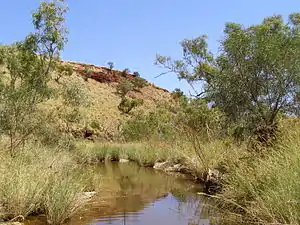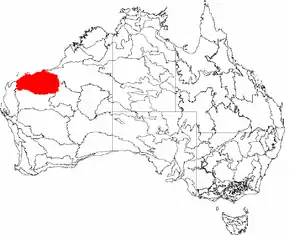Pilbara shrublands
The Pilbara shrublands is a deserts and xeric shrublands ecoregion in Western Australia. It is coterminous with the Pilbara IBRA region.[2][3] For other definitions and uses of "Pilbara region" see Pilbara.
| Pilbara shrublands | |
|---|---|
 | |
 Map of IBRA regions, with Pilbara in red. | |
| Ecology | |
| Realm | Australasian |
| Biome | deserts and xeric shrublands |
| Borders | Carnarvon xeric shrublands, Great Sandy-Tanami desert, Kimberley tropical savanna, and Western Australian mulga shrublands |
| Geography | |
| Area | 177,693 km2 (68,608 sq mi) |
| Country | Australia |
| States | Western Australia |
| Conservation | |
| Conservation status | Vulnerable |
| Protected | 11,224 km² (6%)[1] |
Geography
The Pilbara shrublands is bounded on the north by the Indian Ocean, and on the west, south, and east by other deserts and xeric shrubland ecoregions - the Carnarvon xeric shrublands to the west, the Western Australian mulga shrublands to the south, and the Great Sandy-Tanami desert to the east and northeast.
The Pilbara geographic region covers most of the ecoregion, and extends east into the Great Sandy desert.
The Hamersley Range, a region of mountain ranges and plateaus dissected by gorges, lies in the southern portion of the ecoregion. The Fortescue Plains extend east and west to the north of the Hamersley Range, forming the upper basin of the Fortescue River. The Chichester Plateau lies north of the Fortescue Plains. The Roebourne subregion encompasses the coastal plain along the Indian Ocean, including the Dampier Archipelago.[4][5]
The ecoregion lies on the Pilbara craton, a block of ancient Archean rock. The Chichester region is characterized by exposed granite and greenstone basement rocks. The Hamersley region includes iron-rich carbonate sedimentary carbonate rocks over a volcanic substrate (the Fortescue formation) which rest on the older craton. The Fortescue basin and coastal plain are alluvial.
Climate
The climate is tropical semi-desert. Rainfall averages 300 mm annually, typically from summer cyclonic storms and thunderstorms.[5]
Flora
In the Hamersley region, mulga woodland occurs on fine-textured valley soils, with Acacia aneura over the grasses Aristida spp. and Enneapogon spp. Snappy gum (Eucalyptus leucophloia) occurs with the grass Triodia brizoides on the skeletal soils of the ranges.[5]
The Fortescue Plains include the northernmost mulga woodlands, along with short grasslands. Year-round watercourses and springs support stands of red river gum, (Eucalyptus camaldulensis refulgens), Melaleuca. and the palm Livistona alfredii. Sheltered gorges along the edge of the Chichester Plateau provide water and protection from fire, and support relict communities of Terminalia, Erythrina, and Ficus.[6]
The Chichester Plateau is principally scrub steppe, with the shrub Acacia inaequilatera and the bunch grass Triodia wiseana. Scrub steppe also dominates the Roebourne coastal plain, with Acacia translucens and Triodia pungens.[4]
Fauna
Native animals include the red kangaroo (Osphranter rufus), bilby (Macrotis lagotis), northern quoll (Dasyurus hallucatus), Pilbara leaf-nosed bat (Rhinonicteris aurantia, Pilbara form), ghost bat (Macroderma gigas), Pilbara ningaui (Ningaui timealeyi), Pilbara olive python (Liasis olivaceus barroni), Pilbara bandy bandy (Vermicella snelli), and Airlie Island ctenotus (Ctenotus angusticeps).[7]
Rothschild's rock-wallaby (Petrogale rothschildi), Pilbara rock monitor (Varanus pilbarensis), Pilbara death adder (Acanthophis wellsi), Pilbara toadlet (Uperoleia saxatilis), and the Pilbara threadtail (Nososticta pilbara) are endemic to the ecoregion.
Subregions
| IBRA regions and subregions: IBRA7 | ||||||
|---|---|---|---|---|---|---|
| IBRA region / subregion | IBRA code | Area | States | scope="col" Location in Australia | ||
| Pilbara | PIL | 17,823,126 hectares (44,041,900 acres) | WA |  | ||
| Chichester | PIL01 | 8,374,728 hectares (20,694,400 acres) | ||||
| Fortescue | PIL02 | 1,951,435 hectares (4,822,100 acres) | ||||
| Hamersley | PIL03 | 5,634,727 hectares (13,923,710 acres) | ||||
| Roebourne | PIL04 | 1,862,236 hectares (4,601,690 acres) | ||||
Protected areas
Protected areas in the ecoregion include Karijini National Park, Millstream-Chichester National Park, Murujuga National Park, Cane River Conservation Park, and Mungaroona Range Nature Reserve.[7]
References
- Eric Dinerstein, David Olson, et al. (2017). An Ecoregion-Based Approach to Protecting Half the Terrestrial Realm, BioScience, Volume 67, Issue 6, June 2017, Pages 534–545; Supplemental material 2 table S1b.
- "IBRA7: Pilbara Bioregion (PIL" (PDF). Retrieved 20 April 2018.
- "IBRA7: Pilbara subregions (PIL01-PIL04" (PDF). Retrieved 20 April 2018.
- Heterick, B.E., B. Durrant, and N.R. Gunawardene (2010). "The ant fauna of the Pilbara Bioregion, Western Australia". Records of the Western Australian Museum, Supplement 78: 157–167 (2010).
- Kendrick, Peter (2001). "Pilbara 3 (PIL3 – Hamersley subregion)". in A Biodiversity Audit of Western Australia’s 53 Biogeographical Subregions in 2002, Department of Conservation and Land Management, Western Australia Government, October 2001.
- Kendrick, Peter (2001). "Pilbara 2 (PIL2 – Fortescue Plains subregion)". in A Biodiversity Audit of Western Australia’s 53 Biogeographical Subregions in 2002, Department of Conservation and Land Management, Western Australia Government, October 2001.
- "Pilbara Conservation Strategy". Department of Parks and Wildlife, Government of Western Australia. 2017.